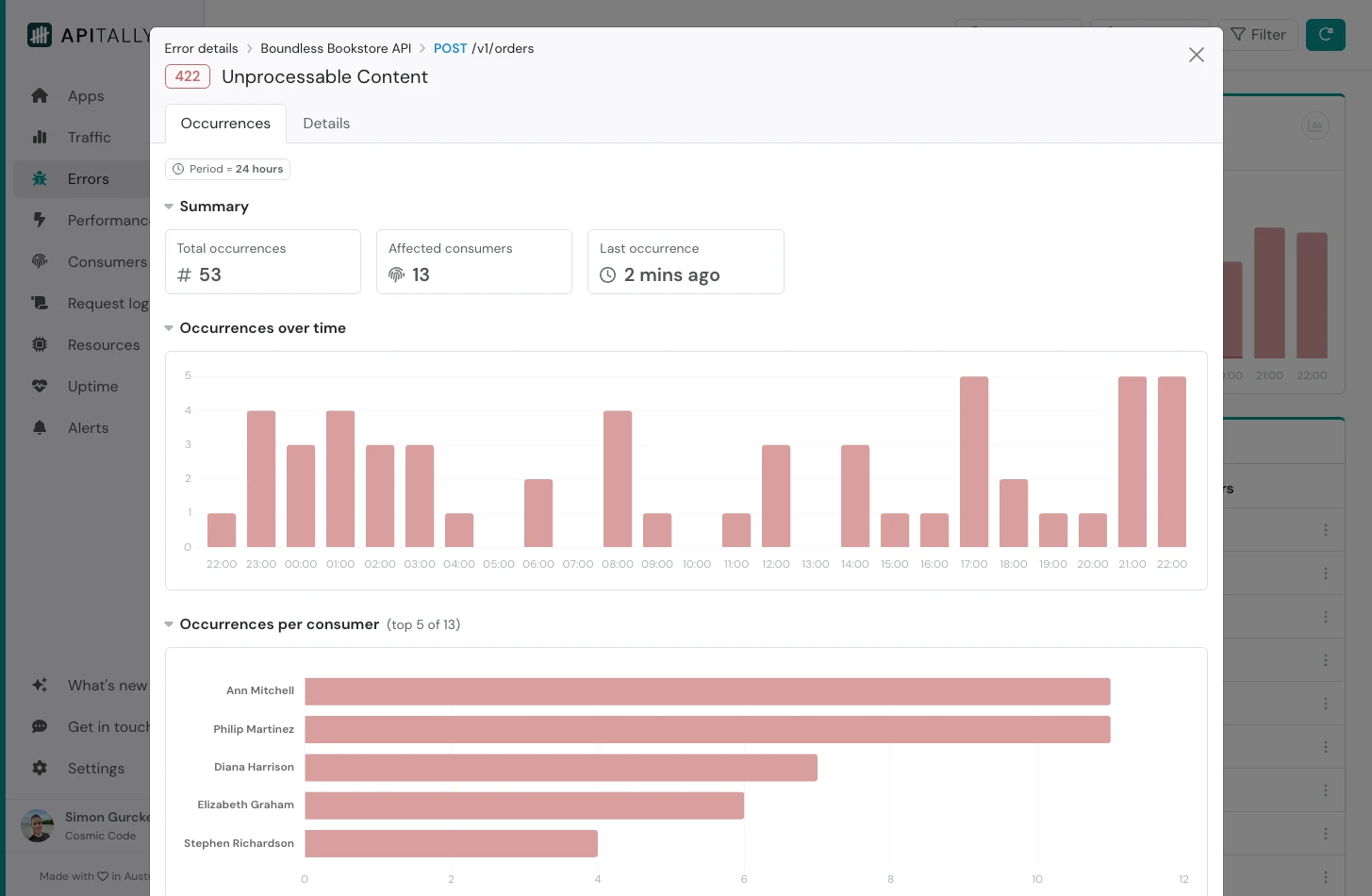Skip to main content The Errors dashboard provides an overview of the error responses returned by your API.
The bar chart at the top shows the distribution of errors over time, broken down by client and server errors.
When you hover over the bars, you’ll see a tooltip with the number of occurrences of each specific status code.
The table below lists all
The Errors dashboard provides an overview of the error responses returned by your API.
The bar chart at the top shows the distribution of errors over time, broken down by client and server errors.
When you hover over the bars, you’ll see a tooltip with the number of occurrences of each specific status code.
The table below lists all 4xx and 5xx status codes returned by your endpoints and is sorted by the number of occurrences.
Clicking on a row opens up a modal with further insights about that type of error.
This includes a summary with the total number of occurrences, the number of affected API consumers and the time of the last occurrence.
A bar chart shows the frequency of the error over time and a second, horizontal bar chart displays the number of occurrences per API consumer, helping you identify which consumers are most affected by the error.
For validation and server errors, the modal includes a Details tab that provides additional information about the error.
Validation errors
Many frameworks offer built-in validation for incoming requests, or are compatible with third-party validation libraries.
Apitally detects commonly used libraries and automatically captures validation error details.
This can help you refine validation rules or reveal issues on the consumer side.
This is currently supported for the following frameworks:
- FastAPI (using pydantic)
- Django Ninja (using pydantic)
- Litestar (using pydantic, attrs or other modeling libraries)
- Express (using express-validator or Joi + celebrate)
- Fastify (using Ajv)
- NestJS (using class-validator)
- Hono (using Zod)
- AdonisJS (using VineJS)
- Elysia
- Chi (using validator)
- Echo (using validator)
- Fiber (using validator)
- Gin (using validator)
Server errors
If a 500 Internal Server Error response is caused by an unhandled exception in your code, Apitally automatically captures the error message and stack trace.
You can review those in the Details tab of the error modal.
Expected errors
In some applications, certain client errors are just part of normal operation.
You might not want these errors included in error rate metrics or combined with other failed requests.
Apitally allows you to mark specific 4xx status codes as expected for certain API endpoints.
This prevents them from being counted as errors in error rate calculations, and requests with these response status codes are considered successful.
To do this, simply select Mark as expected from the dropdown menu in the errors table.
Sentry integration
If your team has set up the Sentry integration under Settings > Integrations, links to the Sentry issues created for captured exceptions will appear in the server error details.  The Errors dashboard provides an overview of the error responses returned by your API.
The bar chart at the top shows the distribution of errors over time, broken down by client and server errors.
When you hover over the bars, you’ll see a tooltip with the number of occurrences of each specific status code.
The table below lists all
The Errors dashboard provides an overview of the error responses returned by your API.
The bar chart at the top shows the distribution of errors over time, broken down by client and server errors.
When you hover over the bars, you’ll see a tooltip with the number of occurrences of each specific status code.
The table below lists all 


